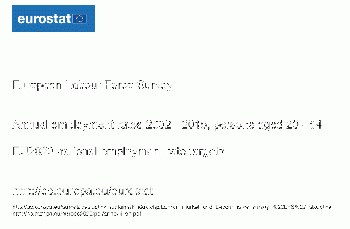Archive:Employment rates – annual statistics
- Data extracted in March 2016. Most recent data: Further Eurostat information, Main tables and Database. Planned article update: April 2017
European Union Labour force survey - Annual employment rates 2015
Author: Håvard Hungnes Lien (Eurostat, Labour market and lifelong learning)
The employment rate tells us what proportion of the adult population has a paid job (or, more technically, is an employed person). The pay can be in cash or in kind, and the job can be as an employee, as self-employed, or as a family worker. As gainful employment in most cases is the main basis for a sufficient living standard for each person, the employment rate tells us something about the social and economic conditions on individual level in a country. It also describes to what extent the human resources of a country are utilised for economic purposes, and thereby also provides key macroeconomic information.
The source for the employment rate calculation is the labour force survey (LFS). The results from the survey currently cover all European Union member states, the EFTA member states of Iceland, Norway, Switzerland, as well as the Former Yugoslav Republic of Macedonia, and Turkey. The survey is based on the same target populations and uses the same definitions in all countries, which means that the results are comparable between the countries. Technical and methodological information is available in the article EU labour force survey - methodology. The LFS is carried out by the national statistics institutes, which send micro data to Eurostat, which again publishes quarterly and annual results for all countries and the EU average.
The employment rate is one of the main indicators of the LFS, and one of the headline indicators under the EU2020 Strategy.
Breakdowns are available for several different age groups (15-64; 15-24; 20-64; 25-54; 55-64) and by sex and by country, per quarter and for annual averages. The full set of updated tables is available at (lfsi_emp_a).
Unless otherwise specified, this article refers to the annual average employment rate of the 20-64 age group.
Most of the EU member states have set targets for what the employment rate should be in 2020, as part of the EU2020 Strategy. This article will also present these national targets in comparison to the current employment rates.
The article on Labour market and Labour force survey (LFS) statistics presents a series of other annual results of the LFS. For deeper insight into the labour market, this article should also be read together with Unemployment statistics and Underemployment and potential additional labour force statistics.
Main statistical findings

Source: Eurostat (lfsi_emp_a) and EU2020 national targets
When considering the time series in Figure 1 (2002 - 2015) it is clear that the crisis hit countries very differently. We can divide them into four groups: no particular effect; clear negative effect; clear positive effect; negative effect during the crisis years, with subsequent recovery.
In the first group we find Italy (59 % in 2002 and 60% in 2015 needs update), Romania (63% to 66%), Slovakia (64 to 66), Belgium (65 to 67), Slovenia (68 to 68) and . . . . .
in the second group (clear negative effect, with no recovery) we find Greece (63 to 53), Spain (63 to 60)
A few countries have had a steady employment rate growth over the whole period of 2002 - 2015, among which Germany is the most notable (a quite remarkable increase from 68 to 78) . malta, poland,
latvia, lithuania, estonia for fall and then recovery
It is also easy to see that the national targets are in many cases markedly higher than what the employment rate has been over the last several years.
Subdivision 2
The situation in 2015 was that
static map in here
Subdivision 1
age and sex breakdowns
tables?
<description and/or analysis of most important statistical data, illustrated by tables and/or figures and/or maps>
Text with Footnote [1]
Data sources and availability
<description of data sources, survey and data availability (completeness, recency) and limitations>
Context
<context of data collection and statistical results: policy background, uses of data, …>
See also
- Name of related Statistics Explained article
- Name of related online publication in Statistics Explained (online publication)
- Name of related Statistics in focus article in Statistics Explained
- Subtitle of Statistics in focus article=PDF main title - Statistics in focus x/YYYY
Further Eurostat information
Data visualisation
- Regional Statistics Illustrated - select statistical domain 'xxx' (= Agriculture, Economy, Education, Health, Information society, Labour market, Population, Science and technology, Tourism or Transport) (top right)
Publications
Publications in Statistics Explained (either online publications or Statistics in focus) should be in 'See also' above
Main tables
- Title(s) of second level folder (if any)
- Title(s) of third level folder (if any)
Database
- Title(s) of second level folder (if any)
- Title(s) of third level folder (if any)
Dedicated section
Methodology / Metadata
<link to ESMS file, methodological publications, survey manuals, etc.>
- Crime and criminal justice (ESMS metadata file — crim_esms)
- Title of the publication
Source data for tables, figures and maps (MS Excel)
Other information
<Regulations and other legal texts, communications from the Commission, administrative notes, Policy documents, …>
- Regulation (EC) No 1737/2005 (generating url [http://eur-lex.europa.eu/LexUriServ/LexUriServ.do?uri=CELEX:32005R1737:EN:NOT Regulation (EC) No 1737/2005]) of DD Month YYYY on ...
- Directive 2003/86/EC (generating url [http://eur-lex.europa.eu/LexUriServ/LexUriServ.do?uri=CELEX:32003L0086:EN:NOT Directive 2003/86/EC]) of DD Month YYYY on ...
- Commission Decision 2003/86/EC (generating url [http://eur-lex.europa.eu/LexUriServ/LexUriServ.do?uri=CELEX:32003D0086:EN:NOT Commission Decision 2003/86/EC]) of DD Month YYYY on ...
<For other documents such as Commission Proposals or Reports, see EUR-Lex search by natural number>
<For linking to database table, otherwise remove: {{{title}}} ({{{code}}})>
External links
Notes
- ↑ Text of the footnote.
[[Category:<Subtheme category name(s)>|Name of the statistical article]] [[Category:<Statistical article>|Name of the statistical article]]
Delete [[Category:Model|]] below (and this line as well) before saving!
